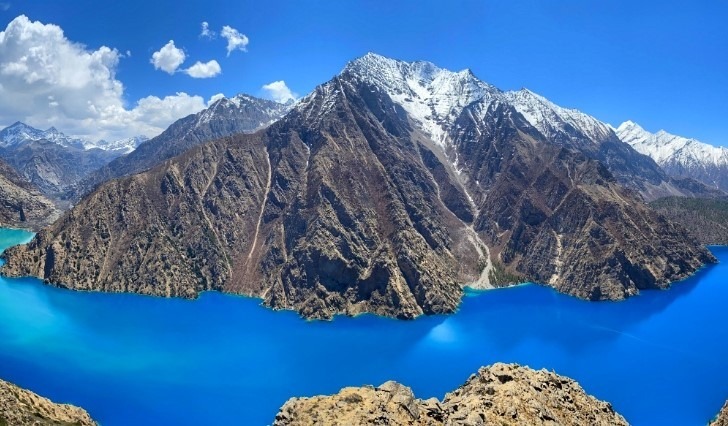Trip Info
-
Nepal
-
Modrate
-
16 Days
-
Hotel/GuestHouse/Tent
-
2-12
-
March, April, May and September, October.
-
8485m
-
2 - 12
Overview
The Lower Dolpa Trek is a challenging and rewarding adventure that takes you through the remote and rugged landscapes of the Dolpa region in Nepal. This trek offers a unique blend of natural beauty, cultural encounters, and high-altitude challenges, including crossing the Bagala Pass and Numa La Pass. Here’s a brief overview of what to expect on this trek:
Key Highlights
- Scenic Flights: Begin with flights from Kathmandu to Nepalgunj and then to Juphal, offering stunning aerial views of the Himalayas.
- Phoksundo Lake: Visit Nepal’s deepest and most beautiful lake with its striking turquoise waters.
- High Pass Crossings: Challenge yourself with the ascents of Bagala Pass (5190m) and Numa La Pass (5310m), providing breathtaking panoramic views of the surrounding peaks.
- Remote Villages: Experience the traditional Tibetan culture in isolated villages like Ringmo, Dho Tarap, and Tarakot.
- Diverse Landscapes: Trek through diverse terrains, from lush forests to arid high-altitude deserts, showcasing the stark contrasts of Dolpa’s geography.
- Cultural Encounters: Visit ancient monasteries, interact with local villagers, and immerse yourself in the unique lifestyle and customs of the Dolpo region.
#Bagala Pass (Baga La)
Elevation: Approximately 5,190 meters (17,027 feet)
Location: Dolpa District, western Nepal
Trek Route: Part of the Lower Dolpa Circuit Trek
Highlights of Bagala Pass
Scenic Views:
Offers panoramic views of the surrounding Himalayan peaks, including Dhaulagiri and other snow-capped mountains.
Spectacular vistas of rugged terrain, deep valleys, and pristine landscapes.
Challenging Terrain:
Similar to Numala Pass, the ascent to Bagala Pass is steep and requires endurance and proper acclimatization.
Trekkers must be prepared for high-altitude conditions and possibly rough weather.
Cultural Encounters:
Passes through remote villages where you can interact with the local communities, including the Dolpo people.
Experience their unique culture, traditions, and way of life in this isolated region.
Natural Beauty:
Traverse diverse landscapes, from alpine meadows to rocky moraines and glaciated valleys.
Opportunities to spot rare wildlife and bird species endemic to the region.
#Numala Pass (Numa La)
Elevation: Approximately 5,310 meters (17,421 feet)
Location: Dolpa District, western Nepal
Trek Route: Part of the Lower Dolpa Circuit Trek
Highlights of Numala Pass
Stunning Views:
Offers breathtaking views of the Dhaulagiri range and other peaks in the Himalayas.
Panoramic vistas of the surrounding valleys and remote landscapes.
Challenging Terrain:
The ascent to the pass is steep and can be challenging, especially with the high altitude.
Trekkers need to be well-acclimatized to handle the thin air and physical exertion.
Cultural Experience:
Passes through remote villages where you can experience the unique culture of the Dolpo people.
Interaction with local communities and witnessing their traditional way of life.
Natural Beauty:
The trail features diverse landscapes, including alpine meadows, rocky terrains, and pristine rivers.
Opportunities to see rare wildlife, including the elusive snow leopard, blue sheep, and various bird species.
Why for choosing a clockwise trek in the Lower Dolpa region
There are several compelling reasons to undertake the Lower Dolpa Trek in a clockwise direction. First and foremost, this route strategically positions trekkers to visit Shey Phoksundo, an iconic and culturally significant site located in Ringmo Village, before tackling the challenging high passes of Numa La and Bagala. This arrangement ensures that trekkers have the opportunity to experience Shey Phoksundo Lake even if adverse weather conditions prevent crossing the passes.
Additionally, choosing the clockwise direction allows for gradual acclimatization as trekkers ascend, enhancing safety and comfort at higher altitudes. This methodical approach also facilitates a deeper understanding of the region’s geographical features and terrain dynamics.
Moreover, following the clockwise route optimizes opportunities for meaningful interactions with local communities and a better appreciation of their customs and traditions. This directionality supports logistical efficiency and cultural immersion throughout the trekking experience.
In summary, opting for a clockwise trek in Lower Dolpa offers strategic advantages, ensuring access to key attractions, safe acclimatization, and enriched cultural engagement along the journey.

